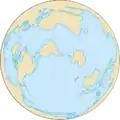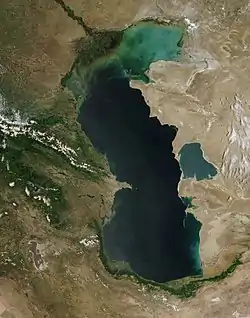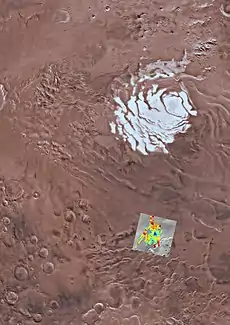List of largest lakes and seas in the Solar System
Listed below are the largest lakes and seas on various worlds in the Solar System. The table includes single bodies of water or other liquid on or near the surface of a solid body (terrestrial planet, planetoid, or moon). All objects on this list are expected to be round, hence anything that is part of a belt or disc is expected to be a dwarf planet.
Cold surface oceans or lakes are found on two worlds, Earth and Saturn's moon Titan. Lava lakes are found on Earth and Jupiter's moon Io. Subsurface oceans or seas occur on the other Galilean moons of Jupiter, Saturn's moons Titan and Enceladus, and are suspected to exist on the some of Saturn's other moons, the asteroid Ceres, the larger trans-Neptunian objects, and ice planets in planetary systems. Recent analysis of the interior of Ganymede (the largest moon of Jupiter), taking into account the effects of salt, suggests that it and some of the other icy bodies may not have a single interior global ocean but several stacked ones, separated by different phases of ice, with the lowest liquid layer adjacent to the rocky mantle below.[1][2] In June 2020, NASA scientists reported that it is likely that exoplanets with oceans may be common in the Milky Way galaxy, based on mathematical modeling studies of their internal heating rates. The majority of such worlds would probably have subsurface oceans, similar to those of the icy moons Europa and Enceladus.[3][4]
List
| Body | Type of object | Lake/sea | Composition | Location | Area (km2) | Average depth (km) | Image | Notes |
|---|---|---|---|---|---|---|---|---|
| Earth | planet (terrestrial) |
World Ocean | salt water | surface | 361,300,000 | 3.68 (max 11.02) |  |
71% of Earth's surface |
| Caspian Sea | salt water | surface | 371,000 | 0.21 (max 1.02) |  |
smallest ocean (geologically) (0.07% of Earth's surface) | ||
| Lake Michigan–Huron | fresh water | surface | 117,400 | 0.07 (max 0.28) | .png.webp) |
largest lake today (geologically) | ||
| West Siberian Glacial Lake | fresh water | surface | c. 880,000 (50–60 ka) |
0.036 | glacial lakes during the Ice Age | |||
| Lake Agassiz | fresh water | surface | c. 440,000 (max) | ? | ||||
| Mars | planet (terrestrial) |
south-polar lake | salt water or brine? | subglacial | c. 200 | (shallow, > 0.2 m) |  |
there may be additional such lakes[5][6] |
| Ceres | asteroid | (internal ocean) | water? water–ammonia mixture? |
subsurface | c. 1,000,000? | possible subsurface equatorial ocean | ||
| Io | moon of Jupiter | Gish Bar Patera | lava | surface | 9,600 | ? |  |
|
| Loki Patera | lava | surface | < 32,000 | ? | .jpg.webp) |
|||
| Europa | moon of Jupiter | (internal global ocean) | water? water–ammonia mixture? |
subsurface | c. 30,000,000 | est. 50–100 | global ocean under 10 to 30 km of ice, perhaps twice the volume of Earth's ocean | |
| Ganymede | moon of Jupiter | (internal global ocean) | salt water? | subsurface | c. 80,000,000 apiece | 100 | 100 km thick, under 150 km of ice, six times the volume of Earth's ocean;[7] possibly three oceans, one under another | |
| Callisto | moon of Jupiter | (internal global ocean) | water? water–ammonia mixture? |
subsurface | c. 65,000,000 | 120–180 | global ocean under 135 to 150 km of ice | |
| Enceladus | moon of Saturn | (internal global ocean) | (salt?) water | subsurface | c. 650,000 | 26–31 or 38 ± 4 | global ocean under 21–26 or 23 ± 4 km of ice, based on libration[8][9] | |
| Dione | moon of Saturn | (internal global ocean) | water? water–ammonia mixture? |
subsurface | c. 2,700,000 | 65 ± 30 | global ocean under 99 ± 23 km of ice[9] | |
| Rhea | moon of Saturn | (internal global ocean) | water? water–ammonia mixture? |
subsurface | c. 1,000,000–2,000,000 | c. 15 | possible global ocean under the ice (c. 400 km)[lower-alpha 1] | |
| Titan | moon of Saturn | Kraken Mare | hydrocarbons | surface | ≈ 400,000 (0.5% of Titan's surface) |
0.85 (max) |  |
only measured bathymetry is in the northern bay, Moray Sinus[12] |
| Ligeia Mare | hydrocarbons | surface | 126,000 | ~0.2[13] | .jpg.webp) |
|||
| Punga Mare | hydrocarbons | surface | 61,000 | ~0.11[13] |  |
|||
| (internal global ocean) | water? water–ammonia mixture? |
subsurface | c. 80,000,000 | < 300 | global ocean of water under < 100 km of ice | |||
| Titania | moon of Uranus | (internal global ocean) | water? water–ammonia mixture? |
subsurface | c. 5,000,000 | c. 15–50 | possible global ocean under the ice (c. 150–200 km) | |
| Oberon | moon of Uranus | (internal global ocean) | water? water–ammonia mixture? |
subsurface | c. 3,000,000 | c. 15–40 | possible global ocean under the ice (c. 250 km) | |
| Triton | moon of Neptune | (internal global ocean) | water? water–ammonia mixture? |
subsurface | c. 20,000,000 | c. 150–200 | possible global ocean under the ice (c. 150–200 km) | |
| Orcus | Kuiper belt object (plutino) |
(internal global ocean) | water? water–ammonia mixture? |
subsurface | c. 500,000 | c. 15 | possible global ocean under the ice (c. 200 km) | |
| Pluto | Kuiper belt object (plutino) |
(internal global ocean) | water? water–ammonia mixture? |
subsurface | c. 10,000,000–15,000,000 | c. 100–180 | possible global ocean under the ice (c. 150–230 km) | |
| Makemake | Kuiper belt object (cubewano) |
(internal global ocean) | water? water–ammonia mixture? |
subsurface | c. 3,000,000 | ? | possible global ocean under the ice | |
| Gonggong | scattered disc object | (internal global ocean) | water? water–ammonia mixture? |
subsurface | c. 2,000,000–3,000,000 | ? | possible global ocean under the ice | |
| Eris | scattered disc object | (internal global ocean) | water? water–ammonia mixture? |
subsurface | c. 10,000,000 | c. 150–200 | possible global ocean under the ice (c. 150–250 km) | |
| Sedna | sednoid | (internal global ocean) | water? water–ammonia mixture? |
subsurface | c. 1,000,000 | c. 15 | possible global ocean under the ice (c. 200 km) |
See also
- List of tallest mountains in the Solar System
- List of largest rifts and valleys in the Solar System
- List of largest craters in the Solar System
- Hydrosphere
Notes
References
- Clavin, W. (2014-05-01). "Ganymede May Harbor 'Club Sandwich' of Oceans and Ice". Press release. Jet Propulsion Laboratory. Archived from the original on 2014-05-02. Retrieved 2014-05-04.
- Vance, S.; Bouffard, M.; Choukroun, M.; Sotin, C. (2014-04-12). "Ganymede's internal structure including thermodynamics of magnesium sulfate oceans in contact with ice". Planetary and Space Science. 96: 62–70. Bibcode:2014P&SS...96...62V. doi:10.1016/j.pss.2014.03.011.
- Shekhtman, Lonnie; et al. (18 June 2020). "Are Planets with Oceans Common in the Galaxy? It's Likely, NASA Scientists Find". NASA. Retrieved 20 June 2020.
- Quick, L.C.; Roberge, A.; Mlinar, A.B.; Hedman, M.M. (2020). "Forecasting Rates of Volcanic Activity on Terrestrial Exoplanets and Implications for Cryovolcanic Activity on Extrasolar Ocean Worlds". Publications of the Astronomical Society of the Pacific. 132 (1014): 084402. doi:10.1088/1538-3873/ab9504.
- Orosei, R.; Lauro, S. E.; Pettinelli, E.; Cicchetti, A.; Coradini, M.; Cosciotti, B.; Paolo, F. Di; Flamini, E.; Mattei, E.; Pajola, M.; Soldovieri, F. (2018-08-03). "Radar evidence of subglacial liquid water on Mars". Science. 361 (6401): 490–493. doi:10.1126/science.aar7268. ISSN 0036-8075. PMID 30045881.
- Lauro, Sebastian Emanuel; Pettinelli, Elena; Caprarelli, Graziella; Guallini, Luca; Rossi, Angelo Pio; Mattei, Elisabetta; Cosciotti, Barbara; Cicchetti, Andrea; Soldovieri, Francesco; Cartacci, Marco; Di Paolo, Federico (2020-09-28). "Multiple subglacial water bodies below the south pole of Mars unveiled by new MARSIS data". Nature Astronomy: 1–8. arXiv:2010.00870. doi:10.1038/s41550-020-1200-6. ISSN 2397-3366.
- "Hubble observations suggest underground ocean on Jupiter's largest moon Ganymede". NASA press release. March 12, 2015. Retrieved 2015-10-03.
- Thomas, P. C.; Tajeddine, R.; Tiscareno, M. S.; Burns, J. A.; Joseph, J.; Loredo, T. J.; Helfenstein, P.; Porco, C. (2016). "Enceladus's measured physical libration requires a global subsurface ocean". Icarus. 264: 37–47. arXiv:1509.07555. Bibcode:2016Icar..264...37T. doi:10.1016/j.icarus.2015.08.037.
- Hussmann, H.; Sohl, F.; Spohn, T. (November 2006). "Subsurface oceans and deep interiors of medium-sized outer planet satellites and large trans-neptunian objects". Icarus. 185 (1): 258–273. Bibcode:2006Icar..185..258H. doi:10.1016/j.icarus.2006.06.005.
- Tortora, P.; Zannoni, M.; Hemingway, D.; Nimmo, F.; Jacobson, R. A.; Iess, L.; Parisi, M. (January 2016). "Rhea gravity field and interior modeling from Cassini data analysis". Icarus. 264: 264–273. Bibcode:2016Icar..264..264T. doi:10.1016/j.icarus.2015.09.022.
- Poggiali, V.; Hayes, A.; Mastrogiuseppe, M.; Le Gall, A. A. (2019-12-01). "The Bathymetry of Moray Sinus at Kraken Mare". AGU Fall Meeting Abstracts. 23.
- Hayes, Alexander G.; Lorenz, Ralph D.; Lunine, Jonathan I. (May 2018). "A post-Cassini view of Titan's methane-based hydrologic cycle". Nature Geoscience. 11 (5): 306–313. doi:10.1038/s41561-018-0103-y. ISSN 1752-0908.